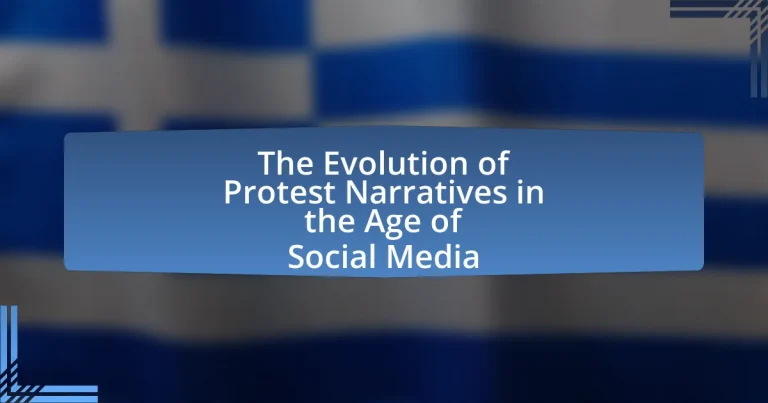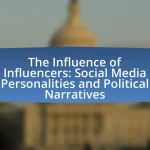Protest narratives in the age of social media are structured accounts that emerge from social movements and are disseminated through digital platforms, significantly shaping public perception and mobilizing support. The article explores the evolution of these narratives, highlighting how social media has transformed traditional messaging into decentralized and diverse forms of communication. It examines the role of various platforms, such as Twitter, Facebook, and Instagram, in influencing protest narratives, as well as the challenges posed by misinformation and censorship. Additionally, the article discusses the importance of emotional resonance, multimedia storytelling, and best practices for activists to ensure authenticity and counter misinformation, ultimately illustrating the profound impact of social media on contemporary social movements.
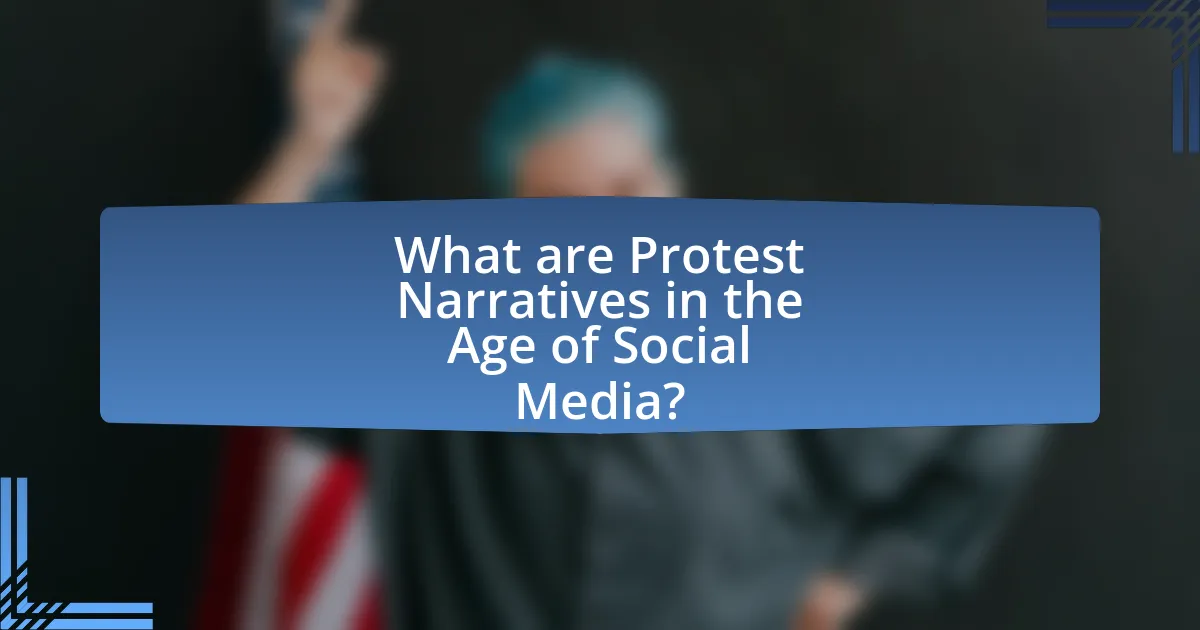
What are Protest Narratives in the Age of Social Media?
Protest narratives in the age of social media are structured stories or accounts that emerge from social movements and are disseminated through digital platforms. These narratives shape public perception, mobilize support, and influence political discourse by leveraging the rapid spread of information online. For instance, the Black Lives Matter movement utilized platforms like Twitter and Instagram to share personal experiences of racial injustice, creating a collective narrative that resonated globally and led to widespread protests in 2020. This demonstrates how social media amplifies voices that might otherwise be marginalized, allowing for diverse perspectives to contribute to the overarching narrative of social change.
How have protest narratives evolved with the rise of social media?
Protest narratives have evolved significantly with the rise of social media, transforming from traditional, centralized messaging to decentralized, diverse, and rapid dissemination of information. Social media platforms enable real-time communication, allowing activists to share their experiences, mobilize supporters, and amplify their messages globally, as seen during movements like the Arab Spring and Black Lives Matter. Research indicates that social media not only facilitates the spread of information but also fosters community building and solidarity among diverse groups, enhancing the visibility and impact of protests. For instance, the hashtag #MeToo illustrates how social media can create a collective narrative that transcends geographical boundaries, empowering individuals to share personal stories and challenge systemic injustices.
What role does social media play in shaping public perception of protests?
Social media significantly influences public perception of protests by providing real-time information and diverse viewpoints. Platforms like Twitter and Facebook enable rapid dissemination of images, videos, and personal accounts, which can amplify the visibility of protests and shape narratives around them. For instance, during the Black Lives Matter movement, hashtags such as #BlackLivesMatter facilitated widespread awareness and engagement, leading to increased public support and participation. Research by the Pew Research Center indicates that 64% of Americans believe social media has a major impact on public opinion regarding social issues, underscoring its role in shaping perceptions of protests.
How do different platforms influence the narrative of protests?
Different platforms significantly influence the narrative of protests by shaping the way information is disseminated and perceived. Social media platforms like Twitter and Facebook allow for real-time updates and grassroots mobilization, enabling diverse voices to contribute to the narrative, which can lead to a more multifaceted understanding of the protest. For instance, during the Black Lives Matter movement, Twitter served as a critical tool for activists to share experiences and organize events, amplifying marginalized voices that traditional media often overlooked. In contrast, platforms like Instagram focus on visual storytelling, which can create emotional connections and drive engagement but may also simplify complex issues into easily digestible images. Research by the Pew Research Center indicates that 64% of Americans believe social media has a major impact on the way protests are perceived, highlighting the platforms’ role in framing narratives and influencing public opinion.
Why are protest narratives important in contemporary society?
Protest narratives are important in contemporary society because they shape public discourse and mobilize collective action. These narratives provide a framework for understanding social injustices, allowing individuals to connect personal experiences with broader systemic issues. For instance, movements like Black Lives Matter have utilized protest narratives to highlight racial inequality, leading to significant policy discussions and changes. Research indicates that narratives can influence public opinion and increase engagement, as seen in studies showing that storytelling in activism enhances empathy and support for social causes.
What impact do protest narratives have on social movements?
Protest narratives significantly shape social movements by framing issues, mobilizing supporters, and influencing public perception. These narratives provide a cohesive story that resonates with individuals, fostering a sense of shared identity and purpose among participants. For instance, the Black Lives Matter movement effectively utilized narratives around systemic racism and police brutality to galvanize widespread support and drive policy changes. Research indicates that movements with compelling narratives are more likely to attract media attention and public sympathy, as seen in the Arab Spring, where social media amplified protest stories, leading to international solidarity and action.
How do they affect political discourse and public policy?
Protest narratives in the age of social media significantly influence political discourse and public policy by amplifying marginalized voices and facilitating rapid information dissemination. Social media platforms enable activists to share their experiences and mobilize support, which can shift public opinion and pressure policymakers to respond to social issues. For instance, the Black Lives Matter movement utilized Twitter and Facebook to raise awareness about systemic racism, leading to widespread protests and legislative discussions on police reform in various jurisdictions. This demonstrates how social media-driven narratives can directly impact political agendas and legislative outcomes.
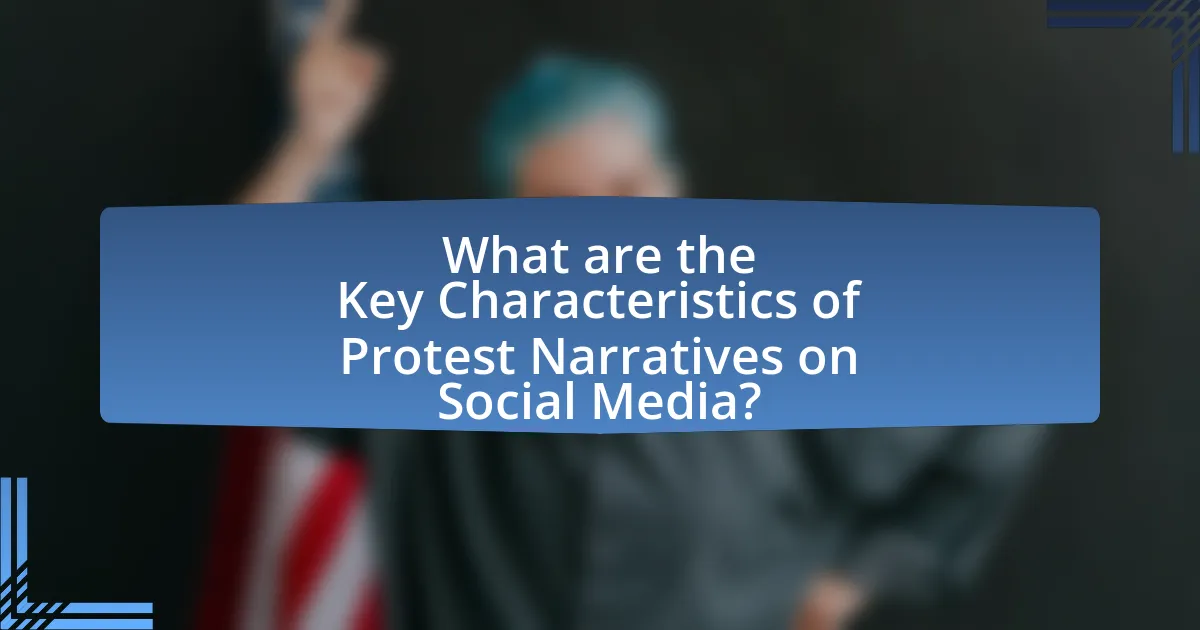
What are the Key Characteristics of Protest Narratives on Social Media?
Key characteristics of protest narratives on social media include immediacy, emotional resonance, and participatory engagement. Immediacy allows for real-time updates and rapid dissemination of information, which is crucial during unfolding events. Emotional resonance is achieved through compelling storytelling and visuals that evoke strong feelings, fostering solidarity among participants. Participatory engagement encourages users to contribute their own narratives, share experiences, and mobilize support, creating a collective voice. These characteristics are supported by studies showing that social media platforms significantly enhance the visibility and impact of protest movements, as evidenced by events like the Arab Spring and Black Lives Matter, where hashtags and viral content played pivotal roles in shaping public discourse and mobilization efforts.
How do storytelling techniques differ in social media protest narratives?
Storytelling techniques in social media protest narratives differ primarily in their immediacy and interactivity compared to traditional narratives. Social media allows for real-time updates and direct engagement with audiences, enabling activists to share experiences and mobilize support instantly. For instance, platforms like Twitter and Instagram facilitate the use of hashtags, which can create a collective identity and amplify messages rapidly, as seen in movements like #BlackLivesMatter. This immediacy contrasts with traditional media, where narratives are often curated and delayed, limiting audience interaction. Additionally, social media narratives often incorporate multimedia elements, such as videos and images, which enhance emotional resonance and can lead to virality, further distinguishing them from conventional storytelling methods.
What types of narratives are most commonly used in social media protests?
The most commonly used narratives in social media protests include personal stories, collective identity, and calls to action. Personal stories humanize issues, allowing individuals to share their experiences and connect emotionally with a broader audience, as seen in movements like #MeToo. Collective identity narratives foster a sense of belonging and solidarity among participants, often emphasizing shared struggles and goals, which is evident in campaigns like Black Lives Matter. Calls to action serve to mobilize supporters by providing clear directives for participation, such as attending protests or signing petitions, effectively driving engagement and activism. These narrative types are supported by research indicating that emotional resonance and community building are critical for the success of social movements in digital spaces.
How do visuals and multimedia enhance protest narratives?
Visuals and multimedia enhance protest narratives by providing compelling, immediate representations of events that evoke emotional responses and foster engagement. These elements capture attention more effectively than text alone, allowing for rapid dissemination of information across social media platforms. For instance, images and videos from protests can illustrate the intensity of the moment, as seen during the Black Lives Matter protests, where footage of police confrontations went viral, galvanizing support and raising awareness. Research indicates that posts with visuals receive 94% more views than those without, underscoring the importance of multimedia in shaping public perception and mobilizing action.
What challenges do protest narratives face in the digital age?
Protest narratives in the digital age face significant challenges, including misinformation, fragmentation, and algorithmic bias. Misinformation can distort the message and goals of protests, as false narratives spread rapidly across social media platforms, undermining the credibility of genuine movements. Fragmentation occurs when diverse groups within a protest movement struggle to unify their messages, leading to diluted impact and confusion among supporters. Algorithmic bias further complicates the dissemination of protest narratives, as social media algorithms may prioritize sensational content over substantive discussions, limiting the visibility of important issues. These challenges hinder the effectiveness of protest movements and can lead to misrepresentation in public discourse.
How does misinformation affect the integrity of protest narratives?
Misinformation undermines the integrity of protest narratives by distorting facts and shaping public perception negatively. When false information circulates, it can lead to misinterpretations of the protest’s goals, motivations, and actions, ultimately eroding trust among participants and the broader community. For instance, during the Black Lives Matter protests in 2020, misinformation about violent incidents and the motivations behind the protests spread rapidly on social media, leading to polarized views and diminished support for the movement. This illustrates how misinformation can create a fragmented narrative that detracts from the core issues being protested, thereby compromising the overall effectiveness and legitimacy of the movement.
What are the implications of censorship on social media platforms?
Censorship on social media platforms significantly impacts the dissemination of information and the expression of dissent. It restricts users’ ability to share opinions and mobilize for social causes, which can stifle democratic engagement and limit the diversity of viewpoints. For instance, during the Arab Spring, social media was crucial for organizing protests, but subsequent censorship efforts by governments aimed to suppress these narratives, demonstrating how censorship can hinder social movements. Furthermore, studies indicate that excessive censorship can lead to increased polarization, as users may retreat to echo chambers where dissenting views are absent, thereby undermining constructive dialogue.
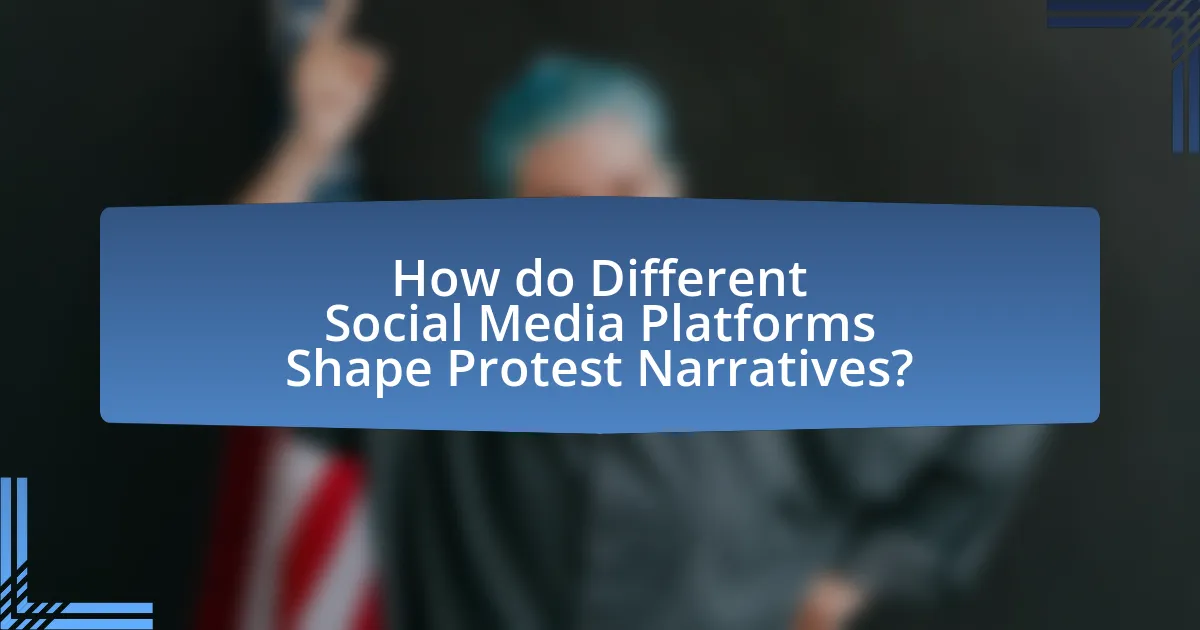
How do Different Social Media Platforms Shape Protest Narratives?
Different social media platforms shape protest narratives by influencing the way information is disseminated, the audience engagement, and the framing of issues. For instance, Twitter’s character limit encourages concise messaging and rapid sharing, which can lead to viral movements, as seen in the Arab Spring where hashtags like #Jan25 mobilized global attention. In contrast, Facebook allows for more detailed storytelling and community building, enabling organizers to create events and foster discussions, exemplified by the Black Lives Matter movement’s use of Facebook to coordinate protests and share personal stories. Instagram, with its visual focus, shapes narratives through imagery, often highlighting emotional aspects of protests, as seen in the widespread sharing of powerful images during the George Floyd protests. Each platform’s unique features thus play a critical role in how protest narratives are constructed and perceived, affecting public engagement and response.
What unique features do platforms like Twitter, Facebook, and Instagram offer for protest narratives?
Twitter, Facebook, and Instagram each provide unique features that enhance protest narratives. Twitter’s character limit encourages concise messaging and rapid dissemination of information, making it ideal for real-time updates during protests. Facebook’s event creation and group functionalities facilitate community organization and mobilization, allowing users to share detailed information and coordinate actions. Instagram’s visual storytelling capabilities enable powerful imagery and videos to capture the emotional essence of protests, fostering engagement and empathy among viewers. These features collectively empower activists to amplify their messages, mobilize support, and document events effectively, as evidenced by movements like Black Lives Matter, which utilized these platforms to reach global audiences and drive social change.
How does the character limit on Twitter influence narrative construction?
The character limit on Twitter significantly influences narrative construction by necessitating brevity and precision in communication. This constraint encourages users to distill complex ideas into concise messages, often leading to the use of abbreviations, hashtags, and emojis to convey meaning efficiently. Research indicates that tweets with fewer characters tend to receive higher engagement, as they are easier to read and share, thus amplifying their reach and impact. For instance, a study by the Pew Research Center found that concise messages are more likely to be retweeted, demonstrating that the character limit shapes how narratives are crafted and disseminated in the context of social movements.
What role does Facebook play in organizing and mobilizing protests?
Facebook serves as a crucial platform for organizing and mobilizing protests by facilitating communication, coordination, and information dissemination among activists. The platform allows users to create event pages, share updates, and engage with a wide audience, which enhances the visibility and reach of protest initiatives. For instance, during the Arab Spring, Facebook was instrumental in organizing protests in countries like Tunisia and Egypt, where activists utilized the platform to coordinate actions and share real-time information, leading to significant political changes. This demonstrates Facebook’s effectiveness in enabling grassroots movements to mobilize quickly and efficiently, thereby playing a pivotal role in contemporary protest dynamics.
How do hashtags function in the context of protest narratives?
Hashtags function as critical tools in protest narratives by facilitating the organization, dissemination, and amplification of messages. They enable activists to categorize content, making it easier for participants and supporters to find and engage with relevant information. For instance, during the Black Lives Matter movement, hashtags like #BlackLivesMatter helped unify diverse voices and experiences, creating a collective identity and fostering solidarity among protesters. Research indicates that hashtags can significantly increase the visibility of social movements, as seen in the 2011 Arab Spring, where hashtags played a pivotal role in mobilizing support and spreading awareness globally.
What are the most effective strategies for hashtag usage in protests?
The most effective strategies for hashtag usage in protests include creating concise, memorable hashtags, leveraging trending topics, and ensuring broad accessibility across platforms. Concise hashtags, such as #BlackLivesMatter, facilitate easy recall and sharing, enhancing visibility. Leveraging trending topics allows protest movements to tap into existing conversations, increasing engagement and reach. Additionally, ensuring accessibility by using simple language and avoiding jargon helps diverse audiences connect with the message. Research indicates that effective hashtag campaigns can significantly amplify protest visibility and mobilization, as seen in the Arab Spring and recent climate change movements, where hashtags played a crucial role in organizing and spreading awareness.
How do hashtags contribute to the spread of protest narratives?
Hashtags significantly enhance the spread of protest narratives by creating a unified and easily searchable label for movements. They facilitate the aggregation of related content, allowing users to quickly access information, share experiences, and mobilize support. For instance, during the Black Lives Matter movement, hashtags like #BlackLivesMatter enabled millions to connect and share their stories, amplifying the message across various social media platforms. This collective engagement not only raises awareness but also fosters a sense of community among participants, which is crucial for sustaining momentum in protest movements.
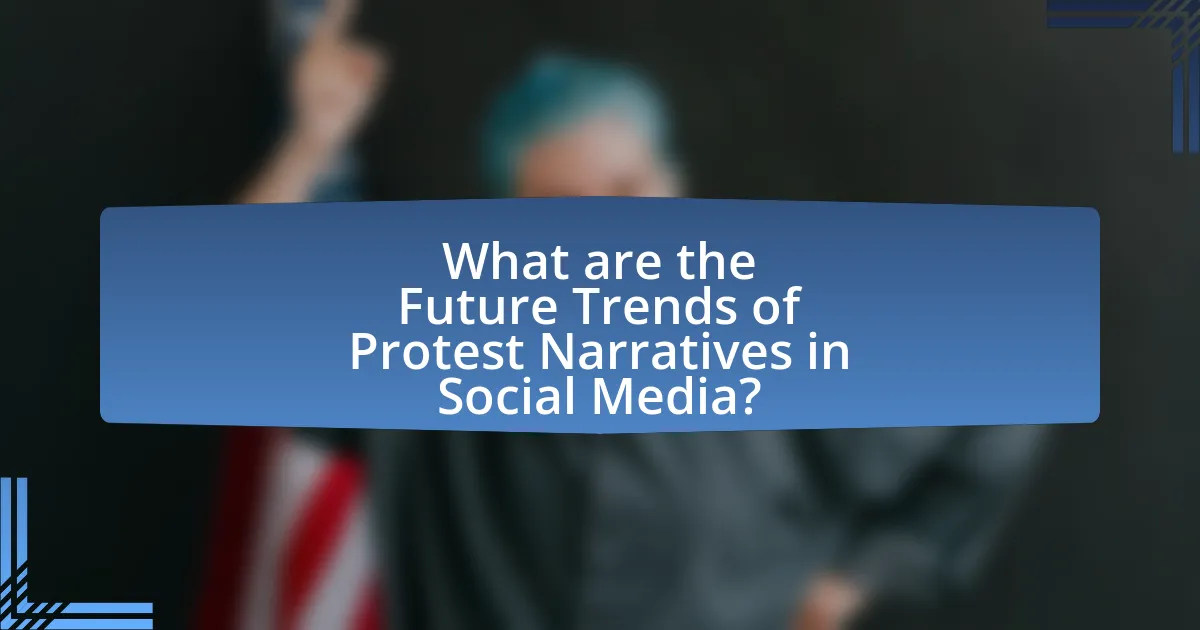
What are the Future Trends of Protest Narratives in Social Media?
Future trends of protest narratives in social media will increasingly focus on decentralized platforms, real-time engagement, and the integration of multimedia storytelling. Decentralized platforms, such as blockchain-based social networks, will empower activists by reducing censorship and enhancing privacy. Real-time engagement will be driven by live streaming and instant updates, allowing narratives to evolve dynamically during protests. Additionally, the use of multimedia storytelling, including videos, infographics, and interactive content, will enhance emotional resonance and broaden audience reach. These trends are supported by the growing reliance on social media for mobilization, as evidenced by the significant role platforms played in movements like Black Lives Matter and climate activism, where visual content and immediate communication were pivotal in shaping public discourse.
How might emerging technologies influence protest narratives?
Emerging technologies significantly influence protest narratives by enabling rapid information dissemination and facilitating real-time communication among activists. For instance, social media platforms like Twitter and Facebook allow protesters to share their experiences, mobilize support, and shape public perception instantly. A study by the Pew Research Center found that 64% of Americans believe social media has a positive impact on political activism, highlighting its role in amplifying voices and narratives that may otherwise be marginalized. Additionally, technologies such as live-streaming and mobile apps provide tools for documenting events, which can alter the narrative by presenting unfiltered perspectives directly from the ground. This shift in narrative control empowers protesters and can lead to greater public engagement and awareness of social issues.
What role will artificial intelligence play in shaping future narratives?
Artificial intelligence will play a crucial role in shaping future narratives by enabling the analysis and generation of content that reflects diverse perspectives and sentiments. AI algorithms can process vast amounts of data from social media platforms, identifying trends and public opinions that inform narrative construction. For instance, AI-driven sentiment analysis tools can gauge public reactions to events in real-time, allowing activists and organizations to tailor their messaging effectively. Furthermore, AI can assist in creating personalized narratives that resonate with specific audiences, enhancing engagement and mobilization efforts. This capability is evidenced by the use of AI in campaigns like the 2020 U.S. presidential election, where data-driven strategies significantly influenced voter outreach and narrative framing.
How can virtual reality and augmented reality change the way protests are experienced and shared?
Virtual reality (VR) and augmented reality (AR) can significantly transform the experience and sharing of protests by providing immersive environments that enhance emotional engagement and understanding. VR allows users to experience protests as if they were physically present, fostering empathy and a deeper connection to the issues at hand. For instance, platforms like Oculus have hosted VR experiences that simulate protests, enabling users to witness events from various perspectives, which can lead to increased awareness and advocacy.
AR can overlay real-time information and narratives onto physical spaces, allowing individuals to engage with protest messages in their own environments. For example, AR applications can display statistics, personal stories, or historical context related to a protest when users point their devices at specific locations or symbols. This interactive layer can enhance the educational aspect of protests, making the information more accessible and engaging.
Research indicates that immersive technologies can lead to greater retention of information and emotional responses, which are crucial for mobilizing support and fostering solidarity. A study published in the journal “Computers in Human Behavior” found that VR experiences can evoke stronger emotional reactions compared to traditional media, suggesting that these technologies can be powerful tools for social movements.
What best practices can activists adopt for effective protest narratives?
Activists can adopt several best practices for effective protest narratives, including clarity, emotional resonance, and strategic use of social media. Clarity ensures that the message is easily understood, which is crucial for mobilizing support; for instance, the Black Lives Matter movement effectively used clear slogans like “I Can’t Breathe” to convey their message. Emotional resonance engages audiences on a personal level, as seen in the #MeToo movement, which shared personal stories to highlight systemic issues. Additionally, strategic use of social media platforms allows activists to reach wider audiences quickly; research indicates that social media campaigns can increase engagement by up to 50%, amplifying the protest narrative’s impact.
How can activists ensure their narratives are authentic and resonate with audiences?
Activists can ensure their narratives are authentic and resonate with audiences by grounding their messages in personal experiences and community stories. This approach fosters emotional connections and relatability, which are crucial for engagement. Research indicates that narratives rooted in real-life experiences are more persuasive; for instance, a study published in the Journal of Communication found that personal storytelling significantly enhances audience empathy and support for social causes. By actively involving community members in narrative creation, activists can reflect diverse perspectives, thereby increasing the authenticity and relevance of their messages.
What strategies can be employed to counter misinformation in protest narratives?
To counter misinformation in protest narratives, employing fact-checking initiatives is essential. Fact-checking organizations, such as Snopes and PolitiFact, actively verify claims made in protest narratives, providing accurate information to the public. Additionally, promoting media literacy among the audience helps individuals critically evaluate sources and discern credible information from misinformation. Research indicates that media literacy programs can significantly improve individuals’ ability to identify false information (Hobbs, 2010). Furthermore, leveraging social media platforms to disseminate verified information quickly can mitigate the spread of false narratives, as studies show that timely corrections can reduce the impact of misinformation (Vosoughi et al., 2018). Engaging community leaders and influencers to share accurate information can also enhance trust and credibility in the messaging.
